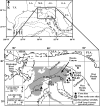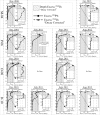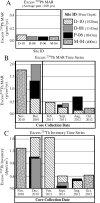Sedimentation Pulse in the NE Gulf of Mexico following the 2010 DWH Blowout
- PMID: 26172639
- PMCID: PMC4501746
- DOI: 10.1371/journal.pone.0132341
Sedimentation Pulse in the NE Gulf of Mexico following the 2010 DWH Blowout
Abstract
The objective of this study was to investigate the impacts of the Deepwater Horizon (DWH) oil discharge at the seafloor as recorded in bottom sediments of the DeSoto Canyon region in the northeastern Gulf of Mexico. Through a close coupling of sedimentological, geochemical, and biological approaches, multiple independent lines of evidence from 11 sites sampled in November/December 2010 revealed that the upper ~1 cm depth interval is distinct from underlying sediments and results indicate that particles originated at the sea surface. Consistent dissimilarities in grain size over the surficial ~1 cm of sediments correspond to excess (234)Th depths, which indicates a lack of vertical mixing (bioturbation), suggesting the entire layer was deposited within a 4-5 month period. Further, a time series from four deep-sea sites sampled up to three additional times over the following two years revealed that excess (234)Th depths, accumulation rates, and (234)Th inventories decreased rapidly, within a few to several months after initial coring. The interpretation of a rapid sedimentation pulse is corroborated by stratification in solid phase Mn, which is linked to diagenesis and redox change, and the dramatic decrease in benthic formanifera density that was recorded in surficial sediments. Results are consistent with a brief depositional pulse that was also reported in previous studies of sediments, and marine snow formation in surface waters closer to the wellhead during the summer and fall of 2010. Although sediment input from the Mississippi River and advective transport may influence sedimentation on the seafloor in the DeSoto Canyon region, we conclude based on multidisciplinary evidence that the sedimentation pulse in late 2010 is the product of marine snow formation and is likely linked to the DWH discharge.
Conflict of interest statement
Figures






Similar articles
-
Hydrocarbons in Deep-Sea Sediments following the 2010 Deepwater Horizon Blowout in the Northeast Gulf of Mexico.PLoS One. 2015 May 28;10(5):e0128371. doi: 10.1371/journal.pone.0128371. eCollection 2015. PLoS One. 2015. PMID: 26020923 Free PMC article.
-
Tracing the incorporation of carbon into benthic foraminiferal calcite following the Deepwater Horizon event.Environ Pollut. 2018 Jun;237:424-429. doi: 10.1016/j.envpol.2018.02.066. Epub 2018 Mar 15. Environ Pollut. 2018. PMID: 29502005
-
Constraining the Spatial Extent of Marine Oil Snow Sedimentation and Flocculent Accumulation Following the Deepwater Horizon Event Using an Excess 210Pb Flux Approach.Environ Sci Technol. 2017 Jun 6;51(11):5962-5968. doi: 10.1021/acs.est.7b00450. Epub 2017 May 26. Environ Sci Technol. 2017. PMID: 28502163
-
Was the extreme and wide-spread marine oil-snow sedimentation and flocculent accumulation (MOSSFA) event during the Deepwater Horizon blow-out unique?Mar Pollut Bull. 2015 Nov 15;100(1):5-12. doi: 10.1016/j.marpolbul.2015.08.023. Epub 2015 Sep 8. Mar Pollut Bull. 2015. PMID: 26359115 Review.
-
Ecological impacts of the deepwater horizon oil spill: implications for immunotoxicity.Toxicol Pathol. 2012;40(2):315-20. doi: 10.1177/0192623311428474. Epub 2011 Nov 21. Toxicol Pathol. 2012. PMID: 22105647 Review.
Cited by
-
Petrocarbon evolution: Ramped pyrolysis/oxidation and isotopic studies of contaminated oil sediments from the Deepwater Horizon oil spill in the Gulf of Mexico.PLoS One. 2019 Feb 28;14(2):e0212433. doi: 10.1371/journal.pone.0212433. eCollection 2019. PLoS One. 2019. PMID: 30818376 Free PMC article.
-
Characterizing the variability of benthic foraminifera in the northeastern Gulf of Mexico following the Deepwater Horizon event (2010-2012).Environ Sci Pollut Res Int. 2017 Jan;24(3):2754-2769. doi: 10.1007/s11356-016-7996-z. Epub 2016 Nov 11. Environ Sci Pollut Res Int. 2017. PMID: 27837470
-
Chemical Dispersant Enhances Microbial Exopolymer (EPS) Production and Formation of Marine Oil/Dispersant Snow in Surface Waters of the Subarctic Northeast Atlantic.Front Microbiol. 2019 Mar 20;10:553. doi: 10.3389/fmicb.2019.00553. eCollection 2019. Front Microbiol. 2019. PMID: 30949150 Free PMC article.
-
The impact of the Deepwater Horizon blowout on historic shipwreck-associated sediment microbiomes in the northern Gulf of Mexico.Sci Rep. 2018 Jun 28;8(1):9057. doi: 10.1038/s41598-018-27350-z. Sci Rep. 2018. PMID: 29955123 Free PMC article.
-
The Interplay of Phototrophic and Heterotrophic Microbes Under Oil Exposure: A Microcosm Study.Front Microbiol. 2021 Aug 2;12:675328. doi: 10.3389/fmicb.2021.675328. eCollection 2021. Front Microbiol. 2021. PMID: 34408728 Free PMC article.
References
-
- Graham WM, Condon RH, Carmichael RH, D’Ambra I, Patterson, Linn LJ, et al. (2010) Oil Carbon entered the coastal planktonic food web during the Deepwater Horizon oil spill. Environ. Res. Lett. 5: 045301.
-
- Joye SB, MacDonald IR, Leifer I, Asper V, (2011) Magnitude and oxidation potential of hydrocarbon gases released from the BP oil well blowout. Nat. Geosci. 4: 160–164.
-
- Thibodeaux LJ, Valsaraj KT, John VT, Papadopoulos KD, Pratt LR, Pesika NS, et al. (2011) Marine oil fate: knowledge gaps, basic research, and development needs; a perspective based on the Deepwater Horizon spill. Environ. Eng. Sci. 28: 87–93.
Publication types
MeSH terms
Substances
LinkOut - more resources
Full Text Sources
Other Literature Sources
Medical

